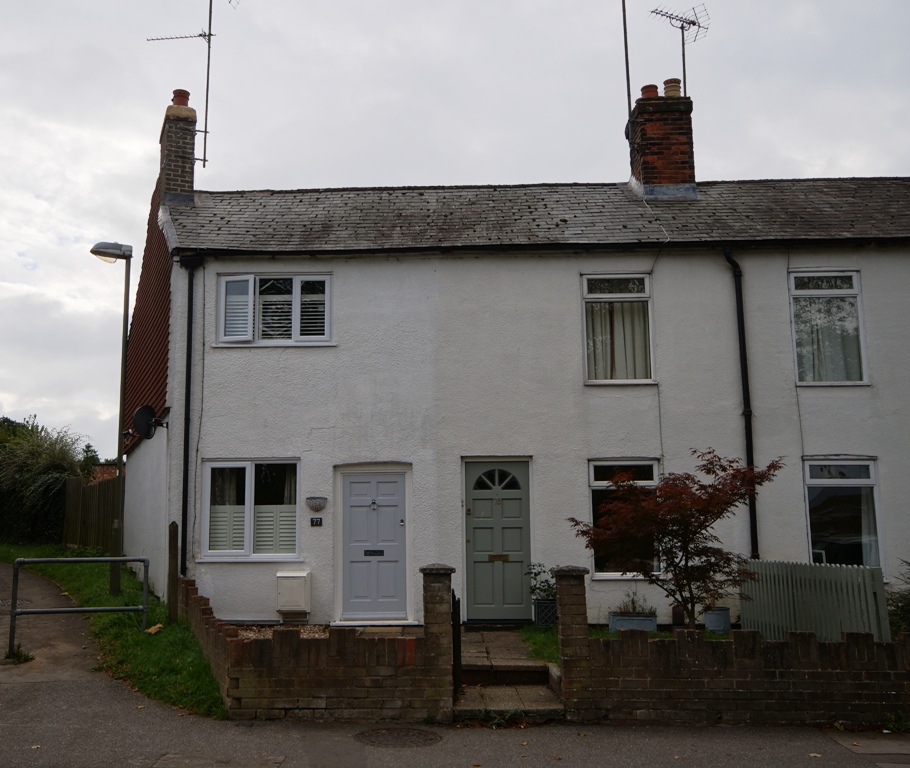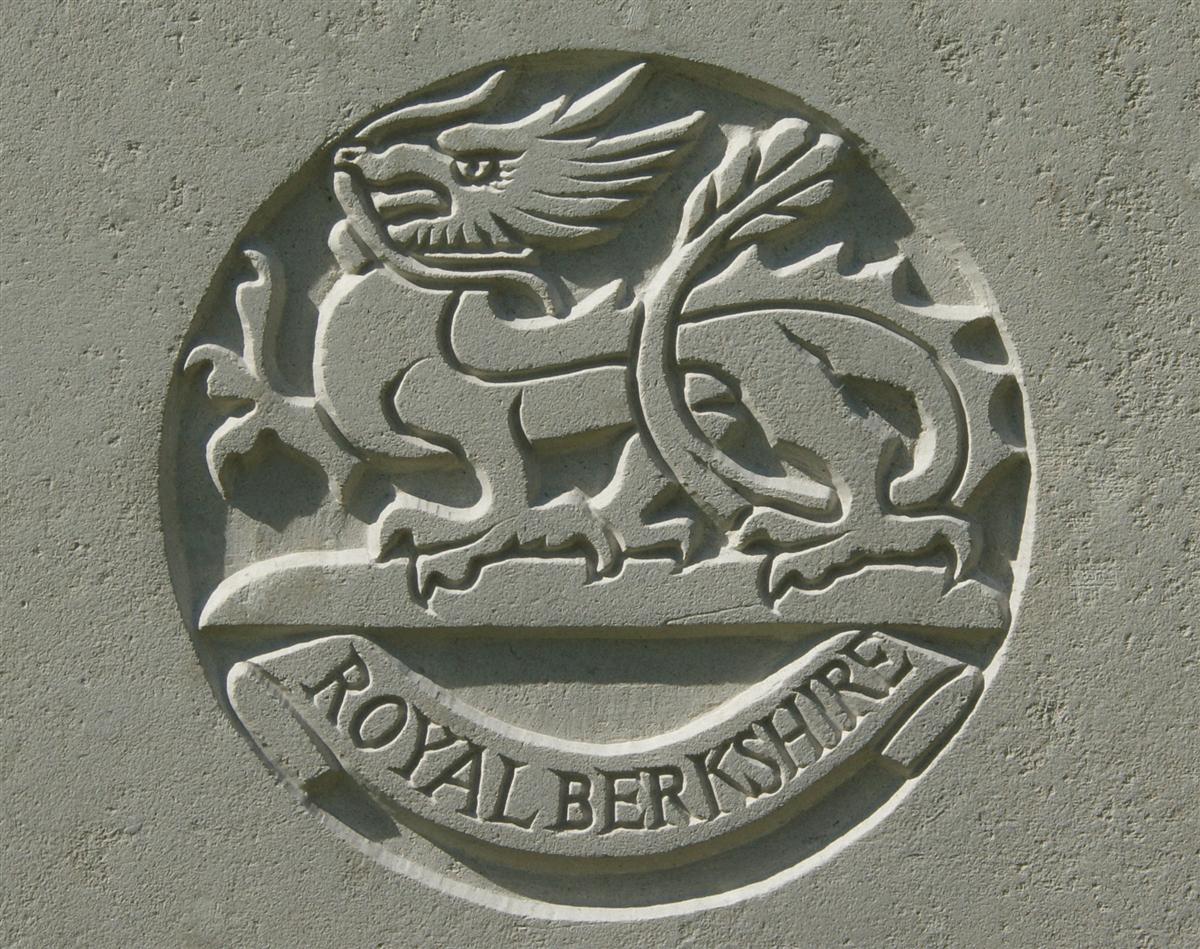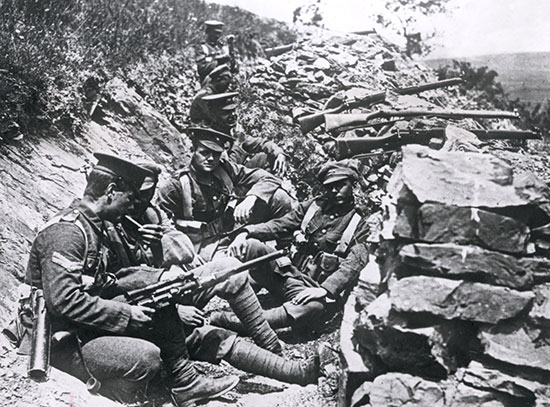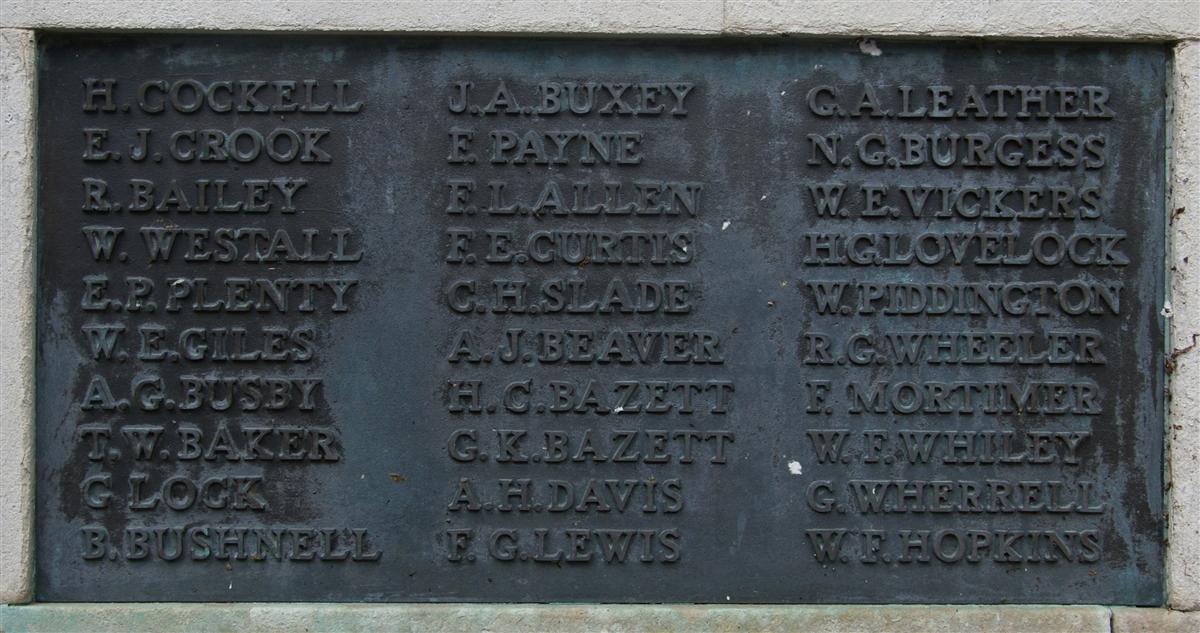Walter Edwin Vickers
Acting Company Sergeant Major 14543 Walter Edwin Vickers, 7th Battalion, Royal Berkshire Regiment

77 Greenham Road (left) - 15 Smith's Buildings in 1916. |
Walter Edwin Vickers was born in Greenham in 1889 the son of William Vickers and his wife Susan Emma née Dixon. Mother and son both went by their second names, Emma and Edwin (Ted to his friends). William, a bricklayer, and Emma married in 1873 and raised a family of six children at 15 Smith’s Buildings in Greenham Road. Since house numbering was introduced after the Great War their home has been 77 Greenham Road.
Ted’s siblings, all born in Greenham, were Arthur Ernest (born 1877), Edith Maud (1880), Florence Mary (1881), Ada Fanny (1883), and George (c1887). A seventh child died in infancy.
Ted probably attended the Greenham parish school at the top of Pyle Hill until he was 12 or 13. By the time of the 1911 census he was working as a bricklayer, a trade he may well have learnt from his father. He also found time to serve with the Newbury company of the Volunteers – the predecessors of the Territorial Force. In 1908 the Territorials were created amalgamating local Volunteers and Militia into a part time army organised on the same lines as the Regular Army. The local infantry volunteers from the Newbury district became a company of the 4th Royal Berkshire Regiment. Terms of service were for four years, with the option to renew.

The regimental badge of the Berkshire Regiment, as used on CWGC headstones. |
By the time war was declared in August 1914 Ted’s commitment to the Territorials was in the past, so he was not subject to mobilisation. As he watched the Territorials leave for service he may well have thought he was missing out – at the time the war was seen as a great adventure, young men were hurrying to enlist in case they missed out on the fun!
Ted did not hesitate for long, on 7 September 1914 he enlisted into the Royal Berkshire Regiment as a ‘Kitchener’ volunteer. However, he was not the typical Kitchener man, he had some military experience, he knew how to shoot a rifle, he knew parade ground drill, he was manna from heaven for the officers of his new home – the 7th (Service) Battalion, Royal Berkshire Regiment. By 11 October 1914 his experience had been recognised and he was promoted to Lance Corporal; on 23 October he skipped Corporal and became Sergeant Vickers.
For the coming months his job was to turn callow civilian youths into soldiers – considering his own experience was limited this must have been a challenge, but it seems that it was one that he did well in.
On 20 September 1915 the 7th Royal Berks landed at Le Havre on their way to the front as part of 78th Brigade, 26th Division. However, the 26th Division was not in France for long, on 11 November it left France from Marseilles, bound for Greece where a new front was being opened in northern Greece (Salonica) in support of Serbia against Bulgarian and Austro-Hungarian forces. The Division spent the rest of the war on this front through to the final defeat of Bulgaria in September 1918 and beyond.
Ted’s excellent service as an NCO was further recognised when he was appointed Company Sergeant Major albeit as a temporary promotion. This may have been pending official promotion to the rank, or it may be that he was deputising while the CSM was on leave or sick.
The battalion was ordered to carry out a raid on Hill 380 (the military had the habit of naming hills by their height) to take place on 23 December 1916. This raid was to be undertaken by D Company led by Capt R A B Chancellor. The first enemy trench was easily occupied following an effect artillery barrage but the second wave suffered severely attempting to go beyond this trench. Captain Chancellor was killed and the two platoon commanders leading the two waves of the assault (2nd Lieutenants Hayter and Thompson) were both wounded. Ted was another victim of this raid one of five other ranks killed. From the newspaper report of the death (below) is seems that he was with one of the two assault waves, probably the second, and had taken command of the platoon when his officer was wounded. Ted was severely wounded by shell fire and died while being carried off the field of battle.
The raid was reported in the local papers, including mention of Ted’s death:

British troops in a trench on the Salonika front. |
Towards the end of December the Berkshires suffered the loss of another promising officer in Capt R A B Chancellor, the elder son of Mr & Mrs Beresford Chancellor of Wargrave. The raid was preceded by a four-days bombardment and in the course of the enemy’s retaliation Lt P H Williams, ward of Mr H T Pugh, the Reading education secretary was on December 22nd severely wounded in the right thigh and left foot, one of his toes having to be removed. The enemy had been shelling with some 5.9s and broke all the telephone wires. As signal Lieut Williams was out with his men repairing the wires when a shell came knocking him over and causing the injuries described. The raid which was carried out by D Company was on Hill 380 and was led by Capt Chancellor. He was hit on the way out, but refused to be brought in and continued to lead his men, when he was again wounded, this time mortally. Acting CSM Vickers was killed on the same occasion. Great credit is due to Lieut Troup. He stayed behind and saw the whole company back into the trenches, being the last man to come in. Second Lieut Hayter, Manchester Regiment attached Royal Berks was wounded in this affair.
Second Lieut H B Thompson was awarded the Military Cross for his gallantry in connection with this stunt. The official story was as follows:- " He led his men in the face of heavy fire over the captured trench and took up a position in readiness to meet a possible counter-attack. Later, although wounded, he took out a patrol and obtained most valuable information" The raid was carried out at dusk, and at dawn Second Lieut Thompson went out with a couple of men and brought in two or three wounded men who were still lying there. He also collected the accoutrements which had been dropped in the raid and made a thorough examination of the damage we had done, sending in a detailed report on his return. The battalion were delighted when it became known he had been awarded the Military Cross for his great pluck.
We greatly regret to state that in the official casualty list of May 9th Second Lieut Thompson was reported wounded and missing.
His family received the news from the War Office and placed an announcement in the Newbury paper:
Newbury Weekly News, 18 January 1917 – Killed in Action
VICKERS – Dec 23, Sergt Walter Edwin (Ted) Royal Berks Regt, Mediterranean Force, youngest son of the late William and Mrs Vickers, of 15, Smith’s Buildings Newbury, aged 27. – RIP.
A little more information was printed in the news columns:
Newbury Weekly News, 18 January 1917 – Local War Notes
Mrs Vickers of Smith’s Buildings, Stroud Green, has had information that her youngest son, Walter Edwin Vickers, has been killed in action at Salonika. He joined up in September, 1914, and has been out in the Mediterranean some time. He was an ex-Volunteer, having served with the Newbury Company.
Two months later the paper returned to Ted’s death with much more detail:
Newbury Weekly News, 15 March 1917 – Local War Notes
The sad tidings has reached Mrs Vickers, of Smith’s-buildings, Stroud Green, that her son, Sergt W E Vickers (Ted) of the Royal Berks, paid the great price on December 23, 1916. – Enlisting on September 7th, 1914, he was made Lce-Corpl on October 11th, and promoted to Sergt on October 23 of the same year, quite a complimentary record. After training at Codford St Mary and Reading, he was drafted to France on September 9, 1915, and a month later to Salonika. There he was soon face to face with the Bulgarian Army, and it was while leading his platoon (as temporary Sergt-Major) that a shell struck him, and in a very short time indeed whilst being carried off the field, he expired, his last thoughts being for the safety of his rescuers. Testimonies to his efficiency as a non-commissioned officer, his brotherliness and his heroic conduct, have been received from his most intimate comrades, also the Chaplain who performed the last rites. Each letter contains a sympathetic message to the bereaved mother and personal friends, one quoting the beautiful thought of the poet:-
There is not death, what seems so is transition,
This life of mortal breath is but a suburb of the life elysian,
Whose portals we call death.
His family and a mystery admirer (Milly) kept his memory alive with notices in the paper on anniversaries of his death.
Newbury Weekly News, 20 December 1917 – In Memoriam
In loving memory of Sergt W E Vickers, 7th Royal Berks Regt, killed in action at Salonica, December 23, 1916, dearly beloved and youngest son of Mrs Vickers, 15, Smith’s-buildings, Greenham, Newbury, Berks.
He fought for home and loved ones,
He died a hero’s death;
And now he is gone to heaven
God grant him peace and rest.
From his loving Mother, Sister and Brothers
In loving memory of Sergt W E Vickers (Ted), 7th Royal Berks Regt, Salonica Forces, killed in action December 23rd, 1916.
He who plants within our hearts,
All this deep affection;
Giving when the form departs
Fadeless recollection,
Will but clasp the unbroken chain
Close when we meet again. Milly
Newbury Weekly News, 20 December 1918 – In Memoriam
In ever loving memory of Sergt W E (Ted) the dearly beloved and youngest son of Mrs Vickers, Greenham-road, Newbury, 7th Royal Berks Regt, killed in action in Salonica, Dec 23, 1916,.
We had looked for a safe returning,
We longed to clasp your hand,
But God has postponed the meetingl
‘Twill be in a better land.
From his sorrowing mother, sister and brother.
Ted’s death was not the only blow the family had to face in the 1910s; in 1912 his sister Edith died aged only 32, then in 1916, a few months before Ted, his father William died aged 62; and in early 1917, as the family were coming to terms with Ted’s death, his brother, Arthur died aged 40 leaving a widow (Elizabeth née Wickens) and four children (Edith Dorothy, Ernest William, Harold Edwin and Emily) aged between 2 and 15.
Ted is buried in grave B.300 at Karasouli Military Cemetery on the edge of the town of Polykastro (formerly Karasouli). However, this was not his first resting place; his remains were moved to Karasouly in November 1920 from grave 2.G.9 at Caussica Military Cemetery. Caussica (also known as Chaushitsa) is a village in the marshes on the North side of Lake Ardzan. This was probably not his first post-mortem move as Caussica was also used as a Concentration Cemetery before the decision was made to close it.

Ted's name on Newbury War Memorial (upper right) |
After the war the Imperial (now Commonwealth) War Graves Commission had the difficult job of rationalising the burial sites of almost a million dead servicemen. In some cases the decision was made for them if, for instance, the land owner refused to part with the site. In other instances the land was deemed unsuitable (water-logged, too remote) or the site too small. In these cases the remains contained in the battlefield burial grounds were moved to what were classified as Concentration Cemeteries. It is unusual for such a cemetery to be subsequently closed, but this was the case at Caussica.
As burials did not begin at Caussica until over a month after Ted’s death it is very likely that he came from one of the cemeteries concentrated into Caussica:
- Senelle Ravine, a front line position between Doiran town and the Greek border, where the British cemetery contained 95 British graves.
- Gugunci (properly Chuguntsi), a village about four miles North-East of Caussica, where between August 1916, and September 1918, the Field Ambulances buried 154 British soldiers.
- Doldzeli (or La Tortue, or Torquay), a front-line cemetery a mile South West of Lake Doiran with 23 British graves.
- Reselli (or Ereselli), a village three miles North-West of Caussica, where the 13th Manchesters began a cemetery of 31 British graves.
- Kilindir (or Krundirtsi), a village with a railway junction three miles South of Lake Doiran, where 45 British soldiers were buried in two cemeteries.
- Ardzan (Arjan, or Harajinovo), a village two miles West of Caussica, where the 12th Cheshires began a front-line cemetery of 22 British graves.
Of these Senelle Ravine is perhaps the most likely as it was closest to Hill 380, the next nearest being Doldzeli. However, Ted was being evacuated from the battlefield as he died of his wounds; this could have occurred close to one of the Field Ambulances at Gugunci.
Locally Ted was remembered on tablet 8 of the Newbury Town War Memorial; he was also remembered on the roll of honour board in St John the Evangelist’s Church in Newbury before it was destroyed by a German bomb in February 1943.
It is also thought that he may be remembered on the memorial in St Mary’s Church, Greenham – as Edmund Vickers. This is not a convincing identification though, as he was known as Ted, the expansion to Edmund is not unreasonable (especially if he was known that he was not an Edward). However, this presupposes that members of his family, who would have known he was Edwin, were not involved. Nevertheless no alternative has been found to explain Edmund Vickers’ entry on the Greenham memorial.

Find a memorial :
| Died this day: | |
| 15 January 1943 | |
| L C Lawrence | |
| Newbury |

Like this site? Show your appreciation through a donation to a great charity.